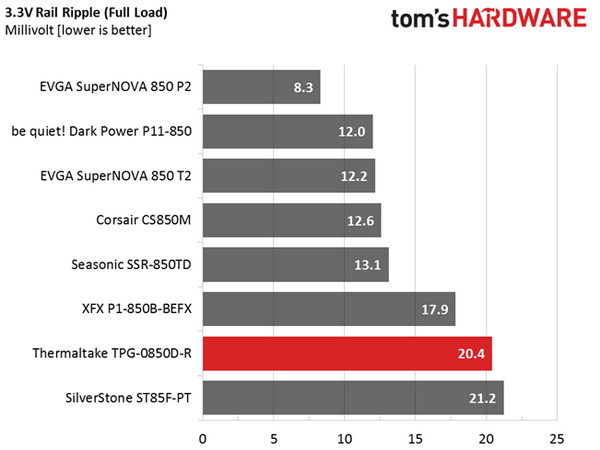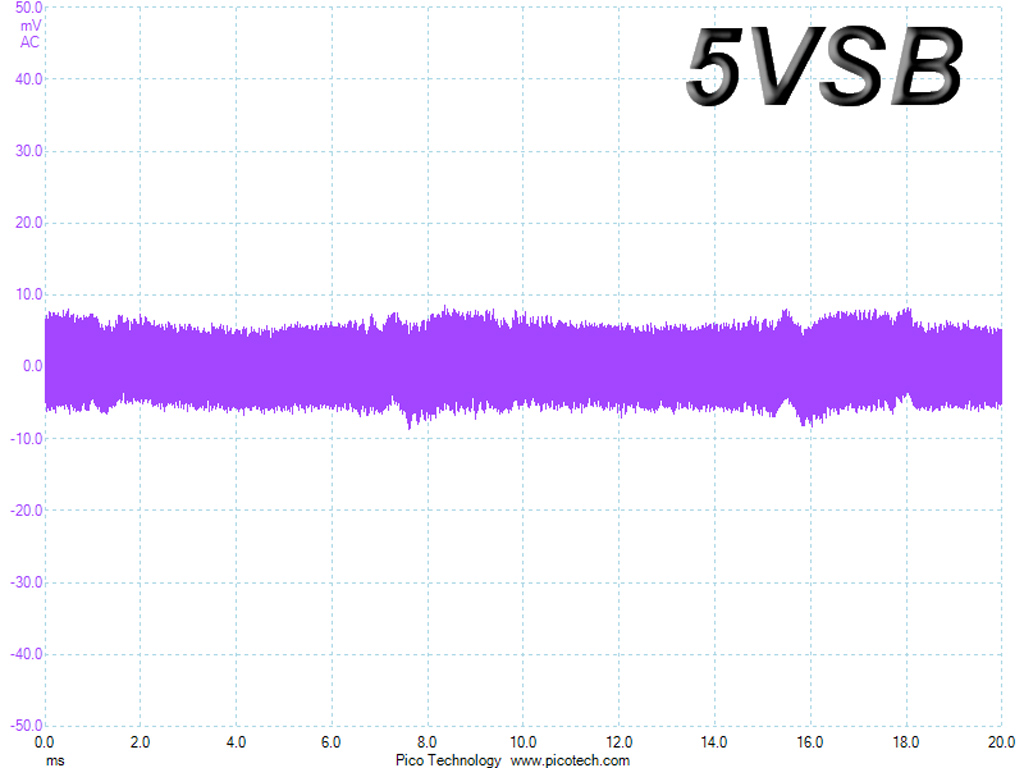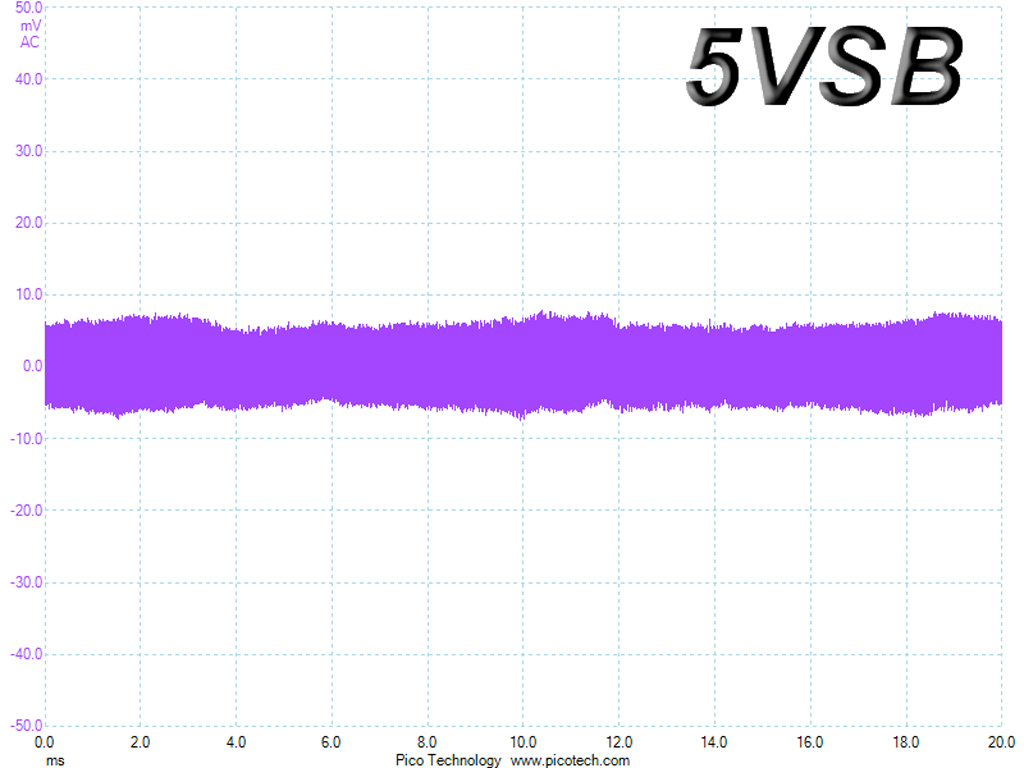Thermaltake Toughpower DPS G RGB 850W PSU Review
In addition to its flagship Titanium line, Thermaltake also equipped the DPS G Gold family with an RGB fan. The highest-capacity model outputting up to 850W is our test subject today.
Why you can trust Tom's Hardware
Ripple Measurements
To learn how we measure ripple, please click here.
The following table includes the ripple levels we measured on the TPG-0850D-R's rails. The limits, according to the ATX specification, are 120mV (+12V) and 50mV (5V, 3.3V, and 5VSB).
| Test | 12V | 5V | 3.3V | 5VSB | Pass/Fail |
|---|---|---|---|---|---|
| 10% Load | 14.3mV | 3.7mV | 6.9mV | 4.4mV | Pass |
| 20% Load | 27.9mV | 5.2mV | 7.5mV | 7.4mV | Pass |
| 30% Load | 21.4mV | 4.6mV | 8.0mV | 6.2mV | Pass |
| 40% Load | 22.0mV | 5.0mV | 9.8mV | 7.6mV | Pass |
| 50% Load | 23.7mV | 5.5mV | 10.2mV | 8.9mV | Pass |
| 60% Load | 22.8mV | 6.1mV | 11.8mV | 9.5mV | Pass |
| 70% Load | 25.1mV | 7.0mV | 12.2mV | 10.7mV | Pass |
| 80% Load | 26.2mV | 7.2mV | 13.3mV | 12.0mV | Pass |
| 90% Load | 30.1mV | 9.6mV | 16.4mV | 16.5mV | Pass |
| 100% Load | 52.1mV | 10.2mV | 19.3mV | 18.0mV | Pass |
| 110% Load | 74.3mV | 11.1mV | 20.4mV | 20.1mV | Pass |
| Cross-Load 1 | 46.1mV | 7.8mV | 10.5mV | 6.1mV | Pass |
| Cross-Load 2 | 57.7mV | 8.7mV | 18.7mV | 15.7mV | Pass |




Ripple suppression up to 90% load is excellent at +12V. However, under full load it increases significantly, exceeding 50mV. While that's not disturbingly high, it'd be ideal to see the result under 40mV.
On the other hand, the minor rails' ripple remains low, even during the overload test.
Ripple Oscilloscope Screenshots
The following oscilloscope screenshots illustrate the AC ripple and noise registered on the main rails (+12V, 5V, 3.3V and 5VSB). The bigger the fluctuations on the screen, the bigger the ripple/noise. We set 0.01 V/Div (each vertical division/box equals 0.01 V) as the standard for all measurements.
Ripple At Full Load




Ripple At 110-Percent Load




Ripple At Cross-Load 1




Ripple At Cross-Load 2




Get Tom's Hardware's best news and in-depth reviews, straight to your inbox.
Current page: Ripple Measurements
Prev Page Transient Response Tests Next Page Performance, Performance Per Dollar, Noise, And Efficiency Ratings
Aris Mpitziopoulos is a contributing editor at Tom's Hardware, covering PSUs.
-
powernod -It's not exactly a PSU-related question but more likely a general one.Reply
From the pictures from the monitoring software, i can notice that this software is able to measure CPU and GPU temperature. Do you have any idea if such monitoring is (relatively) accurate?
-Excellent review Aris !! -
Aris_Mp it takes readings from the system's (actually the individual components') sensors. If those are accurate then the software's readings will be accurate as well. Normally they are accurate.Reply -
Nuckles_56 That 12V transient response was certainly interesting, I don't think I've seen one do anything like that beforeReply -
turkey3_scratch Reply18886218 said:That 12V transient response was certainly interesting, I don't think I've seen one do anything like that before
Do what? -
Nuckles_56 Reply18886236 said:18886218 said:That 12V transient response was certainly interesting, I don't think I've seen one do anything like that before
Do what?
Go and plummet back down to almost 0V during the test -
turkey3_scratch Reply18887052 said:18886236 said:18886218 said:That 12V transient response was certainly interesting, I don't think I've seen one do anything like that before
Do what?
Go and plummet back down to almost 0V during the test
I don't think you're reading the transient response graph properly. It's not a measure of voltage but a measure of ripple (well, technically that is a measure of voltage but it's more a measure of instantaneous offsets of an average, or a highly zoomed in sector).
That or I am just missing something. I probably am. Not sure what I'm missing though. Forgive my ignorance. -
Nuckles_56 For this graph http://media.bestofmicro.com/ext/aHR0cDovL21lZGlhLmJlc3RvZm1pY3JvLmNvbS9TLzYvNjIxNzk4L29yaWdpbmFsLzEydl9vZmYuanBn/r_600x450.jpg I hope that I'm not reading it that badly wrongReply -
sparkyman215 Fantastic review Aris! I absolutely love reading in depth articles about anything. Terrible PSU for the price, but it's an awesome review. Congrats!Reply